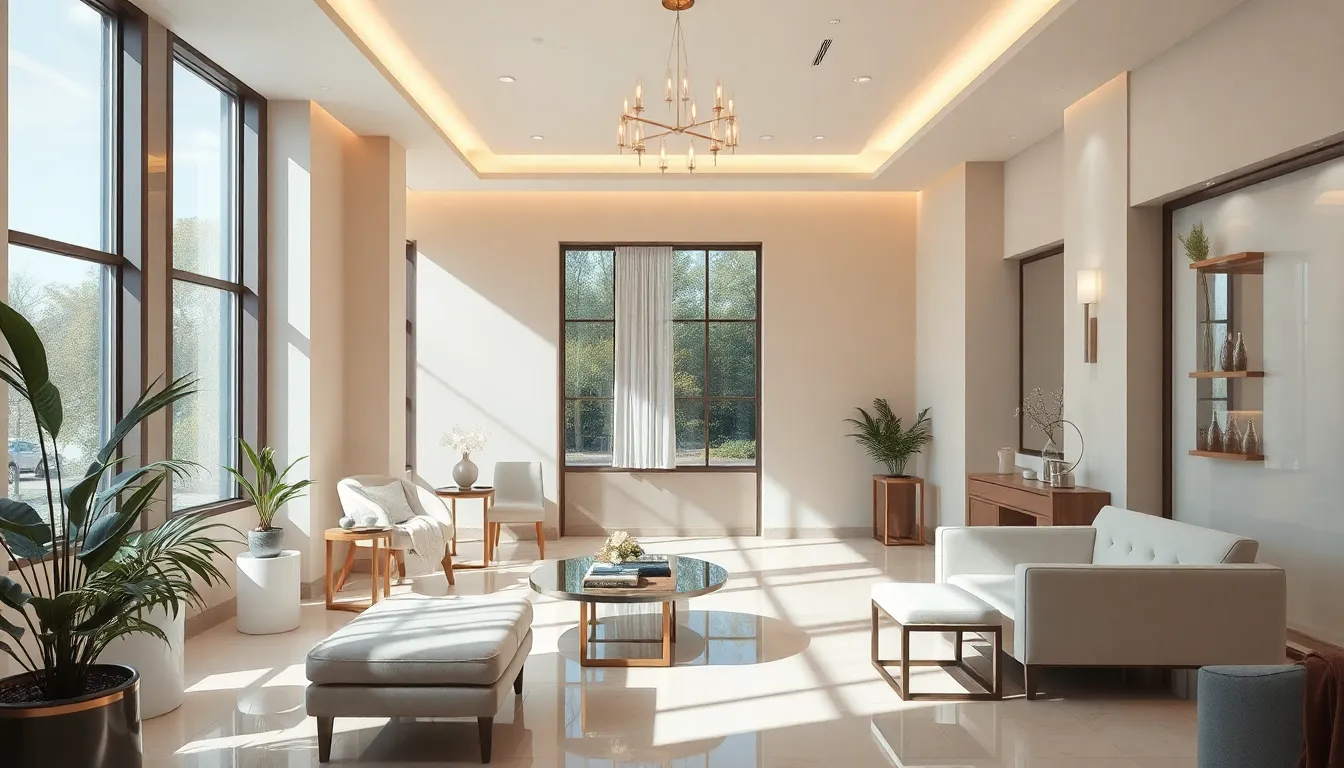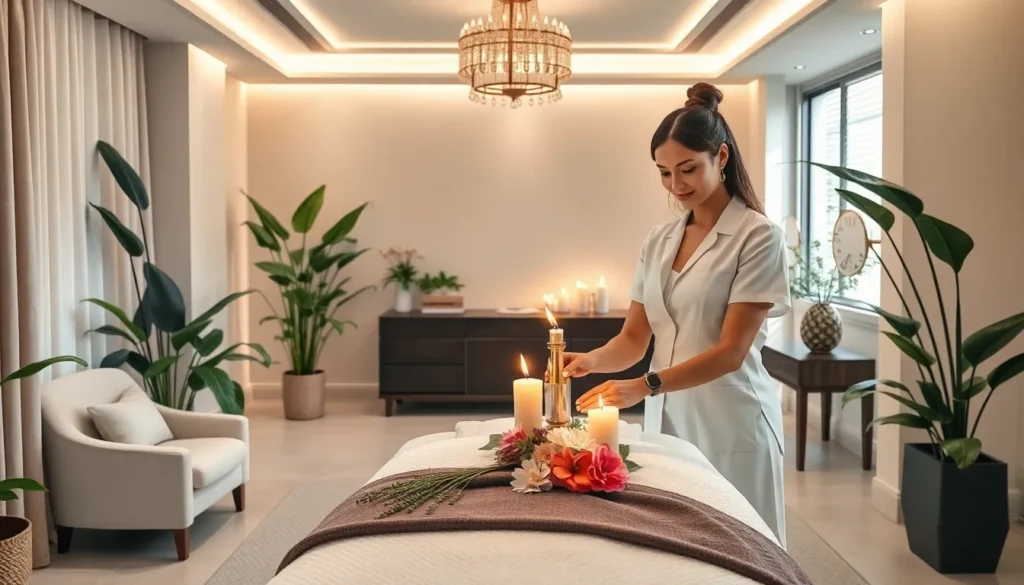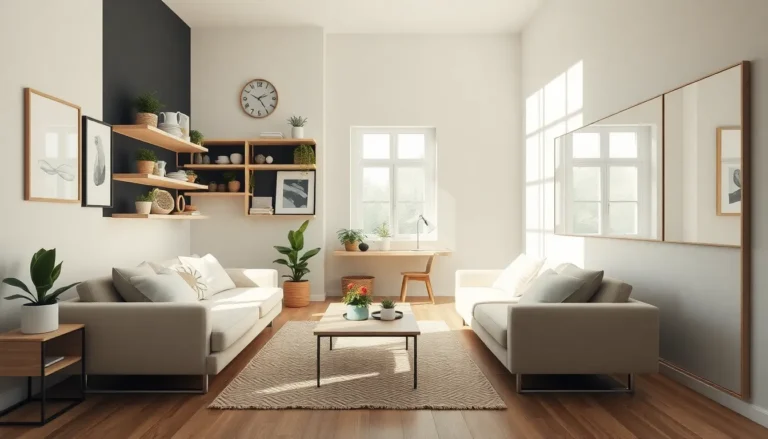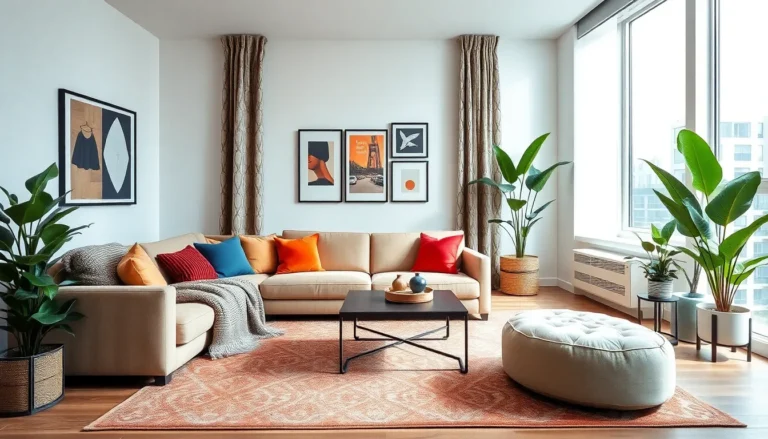Table of Contents
ToggleIn a world where self-care reigns supreme, the ambiance of a med spa can make or break the experience. Imagine stepping into a space that feels like a luxurious retreat rather than a sterile clinic. With the right interior design, a med spa can transform into a sanctuary of relaxation and rejuvenation. It’s not just about looking good; it’s about feeling good too.
Understanding Med Spa Interior Design
Designing a med spa requires a focus on creating a space that promotes wellness and relaxation. Achieving this balance involves thoughtful choices in aesthetics and atmosphere.
Importance of Aesthetic Appeal
Aesthetic appeal sets the tone for the entire med spa experience. Elegantly designed interiors draw clients in through visual interest, influencing their perception of quality. Color palettes, textures, and furniture styles play significant roles in forming this impression. Natural materials and soothing colors often evoke feelings of tranquility. Art pieces and decorative elements enhance the environment, making it inviting and luxurious. Attention to detail, such as curated lighting and functional layouts, ensures that aesthetics align with the overall concept of the spa.
Creating a Relaxing Atmosphere
Creating a relaxing atmosphere requires careful planning and design. Soft lighting helps soften harshness and encourages a sense of calm. Incorporating sound elements, like soft music or water features, can further enhance relaxation. Furnishing spaces with comfortable seating allows guests to unwind. Incorporating greenery, such as indoor plants, adds freshness and promotes well-being. Aroma elements, including essential oil diffusers, contribute to the overall sensory experience. Each of these elements works together to foster an environment where clients feel at ease and rejuvenated.
Key Elements of Med Spa Interior Design

The interior design of a med spa involves several key elements that create an inviting and soothing atmosphere. Attention to detail enhances the overall ambiance and enriches the client experience.
Color Schemes and Mood
Color schemes significantly impact the mood within a med spa. Soft and neutral tones such as beige, soft blues, and pastel greens promote relaxation. Darker shades might bring sophistication but can overwhelm if overused. Incorporating natural colors creates a connection to the environment, supporting overall wellness. Accent colors can highlight specific areas and guide the flow within the space. A balanced palette encourages tranquility and sets a calming tone for client experiences.
Furniture Selection and Layout
Furniture selection plays a critical role in both aesthetics and comfort. Comfortable seating encourages relaxation, while stylish pieces enhance visual appeal. Layout should facilitate easy movement and accessibility, ensuring clients can navigate the space effortlessly. Grouping seating areas fosters a sense of intimacy, allowing for private conversations. Choosing high-quality materials conveys a commitment to excellence, reinforcing a luxurious atmosphere. Versatile furniture can adapt to various treatments or events, maximizing functionality while maintaining an upscale vibe.
Lighting Techniques
Lighting techniques are essential for creating the right environment in a med spa. Soft, diffused lighting promotes a calming atmosphere, while adjustable fixtures allow for customization based on the treatment being offered. Natural light enhances spaces and invites freshness, making clients feel more connected. Incorporating task lighting in treatment rooms ensures practitioners can work effectively, while ambient lighting in waiting areas enhances comfort. Layered lighting options add depth and visual interest, enhancing the overall aesthetic of the med spa.
Design Trends for Med Spas
Current trends in med spa design focus on inviting spaces that blend comfort with aesthetic appeal. Creating a serene environment enhances relaxation while promoting overall wellness.
Biophilic Design
Biophilic design integrates nature into indoor environments. Incorporating natural materials like wood and stone fosters a calming atmosphere. Plants improve air quality and provide soothing visuals. Using large windows for natural light connects clients with the outdoors. Water features, such as fountains, create tranquil sounds. This design approach emphasizes a connection to nature, which improves mental well-being.
Minimalist Aesthetics
Minimalist aesthetics reflect simplicity and elegance. Neutral color palettes with soft whites and beiges evoke calmness and relaxation. Streamlined furniture enhances functionality without cluttering the space. Fewer decorative elements allow essential features to stand out. Openness and spaciousness contribute to an inviting ambiance. Clients feel unburdened in environments that prioritize tranquility and straightforward beauty.
Use of Technology in Design
Smart technology enhances the client experience in modern med spas. Automated lighting adjustments create the perfect ambiance for various treatments. Advanced sound systems can curate personalized music playlists for each visit. Virtual reality options may transport clients to tranquil settings, improving relaxation during procedures. Interactive screens provide educational content, helping clients engage with their experiences. Integrating technology creates a sophisticated, modern atmosphere that elevates the overall experience.
Practical Tips for Implementing Ideas
Implementing thoughtful design ideas in a med spa transforms the space into a rejuvenating retreat. Prioritizing specific elements can enhance both client experience and aesthetics.
Space Planning Considerations
Effective space planning ensures optimal flow and comfort. Begin by considering the layout to create distinct zones for services and relaxation. Designate areas for treatments and waiting by using partitions or furniture arrangements. This method fosters tranquility while maintaining accessibility. Incorporating intimate seating sections encourages conversation and comfort. Evaluate traffic patterns and pathways to prevent congestion, facilitating easy movement throughout the space. Flexible layouts can adapt to various client needs, enhancing functionality without compromising style.
Incorporating Branding in Design
Branding should resonate throughout the med spa’s interior. Establish a cohesive design that reflects your unique identity. Use consistent color palettes, materials, and textures that align with the brand’s message. Integrating logo elements can create a memorable impression on clients. Design signage that enhances visibility without overwhelming the aesthetic. Incorporating branded elements in decor or artwork can reinforce the identity while enhancing the environment. Prioritize subtle branding techniques to maintain an inviting atmosphere while subtly promoting brand recognition.
Creating a med spa that feels like a luxurious retreat is essential for enhancing client experiences. Thoughtful interior design plays a pivotal role in fostering relaxation and wellness. By carefully selecting color palettes textures and furniture styles med spas can significantly influence clients’ perceptions and overall satisfaction.
Incorporating elements like soft lighting soothing sounds and greenery can transform any space into an inviting sanctuary. Current design trends such as biophilic design and minimalist aesthetics further elevate the ambiance while integrating smart technology offers a modern touch.
Ultimately a well-designed med spa not only promotes relaxation but also reinforces the brand’s identity creating a memorable experience that keeps clients returning.







